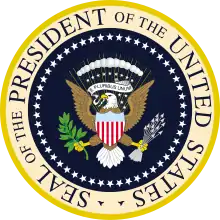First inauguration of Harry S. Truman
The first inauguration of Harry S. Truman as the 33rd President of the United States was held at 7:00 pm on Thursday, April 12, 1945, at the Cabinet Room inside the White House in Washington, D.C., following the death of President Franklin D. Roosevelt earlier that day. The inauguration—the seventh non-scheduled, extraordinary inauguration to ever take place—marked the commencement of the first term (a partial term of 3 years, 283 days) of Harry S. Truman as president.
 President Truman being sworn in, following Roosevelt's death, on April 12, 1945. | |
| Date | April 12, 1945 |
|---|---|
| Location | Cabinet Room, White House, Washington, D.C. |
| Participants | Harry S. Truman 33rd President of the United States — Assuming office Harlan F. Stone Chief Justice of the United States — Administering oath |
← 1945 1949 → | |
Truman, then serving as Vice President of the United States, had just adjourned a session of the United States Senate and was on his way to share a drink with Sam Rayburn, the Speaker of the House of Representatives, when he was summoned to the White House.
Upon his arrival, he was met by Eleanor Roosevelt, who informed him that President Roosevelt was dead. Shocked, Truman asked Mrs. Roosevelt, "Is there anything I can do for you?", to which she replied: "Is there anything we can do for you? For you are the one in trouble now."[1]
Chief Justice of the United States Harlan F. Stone administered the presidential oath of office;[2] Stone began the oath "Do you, Harry Shipp Truman..." in the erroneous belief that Shipp was the President's mother's maiden name and, by extension, his middle name,[3] to which Truman replied, "I Harry S. Truman..."[4] before the oath was continued.
Among witnesses of this ceremony were Truman's wife Bess Truman, daughter Margaret Truman, Mrs. Roosevelt, Speaker Rayburn, and members of the cabinet. This was the second presidential inauguration in 1945, after the regularly scheduled inauguration for Roosevelt's fourth term on January 20.
This event has the distinction of being the first extraordinary inauguration to be photographed: Theodore Roosevelt had ejected the photographers from his 1901 inauguration after they started fighting with each other,[5] and Calvin Coolidge's 1923 inauguration was late at night with no press or electric lighting.[6]
References
- "Eleanor and Harry: The Correspondence of Eleanor Roosevelt and Harry S. Truman". Truman Library. Retrieved 2007-07-26.
- "The swearing in of Harry S. Truman, April 12, 1945". United States Senate. Retrieved April 9, 2020.
- Anderson Shipp Truman was Harry's paternal grandfather, who was known as Shipp for most of his life.
- https://forgottenhistoryblog.com/president-harry-s-truman-didnt-actually-have-a-middle-name/
- https://www.trsite.org/learn/the-day-of-the-inauguration
- http://www.eyewitnesstohistory.com/coolidge.htm
- Newsreel coverage of Truman's first inauguration from C-SPAN (via YouTube)
- Robert J. Donovan, Conflict and Crisis. The Presidency of Harry S. Truman, 1945-1948. University of Missouri Press, 1996 ISBN 0-8262-1066-X, 9780826210661.
